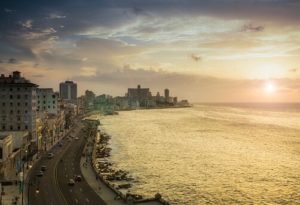LA HABANA, CUBA Y EL CAÑONAZO DE LAS NUEVE, “LA HORA DE LOS MAMEYES”. PHOTOS.

El mamey es una de las frutas más gustadas en Cuba y es originario de la América Tropical y Las Antillas
EN MAYO DE 1762 los ingleses toman La Habana, principal ciudad de la metrópoli española en la isla de Cuba y los capitalinos comienzan a llamar a los invasores de forma jocosa “mameyes” por el color rojinegro de sus uniformes.
Resulta que el uniforme de ceremonia y el de batalla se distinguían por tener una casaca roja y se dice que era para cubrir la sangre de las heridas, y hacerle creer al enemigo que los soldados de la corona de Inglaterra eran inmortales.
A mediados del siglo XVIII la ciudad de La Habana estaba rodeada de una fuerte y gruesa muralla la que la protegía de los ataques de corsarios y piratas. La muralla tenía varias puertas. En esa época era costumbre efectuar un disparo a las 4 y 30 de la madrugada para anunciar a la población que las puertas de la muralla serían abiertas. A las ocho de la noche otro cañonazo advertía que los puentes serían levantados y las puertas cerradas. Se estima que el primer cañón utilizado para este fin fue el denominado “El Fuerte”. Después fueron empleados otros cañones con nombres significativos, tales como Luperto, la Hermosa y otros.
Con el decursar del tiempo el cañonazo fue traspasado para las nueve de la noche.
Cada noche eran cerradas las puertas de la muralla, tras el cañonazo de las nueve y el patrullaje nocturno en las calles habaneras crecía. Entonces nació la frase “La hora de los mameyes”en franca alusión a los soldados de casaca roja y pantalón negro en las rondas callejeras.
Lo mismo ocurría, cuando las autoridades imponían el toque de queda, o los uniformados irrumpían en cualquier lugar de la capital de la mayor de las Antillas perturbando la aparente tranquilidad ciudadana.
Ahora la expresión es empleada al adoptar una decisión seria. Nada que nuestras ocurrencias no están escrita, aún en los momentos más difíciles son “La hora de los Mameyes”.
La ocupación de la Habana, por parte de los ingleses, duró sólo once meses y se utilizaron nada menos que 53 buques de guerra y unos 22 mil hombres, bajo el mando del almirante George Pockock y del Conde de Albemarle George Keppel.
Ahora para el cubano actual puede ser también un momento que se evade con absoluta tranquilidad espiritual, sin conflicto alguno de conciencia, aunque a la hora de los mameyes llueva a cántaros, caigan truenos de punta y hasta un ciclón nos deje como el gallo de Moron, sin plumas y cacareando, y sencillamente, al mal tiempo buena cara.
HAVANA, CUBA AND THE NINE O’CLOCK GUN, “THE TIME OF THE MAMEYES”. PHOTOS.
IN MAY 1762, the English took over Havana, the main city of the Spanish metropolis on the island of Cuba, and the residents of the capital began jokingly calling the invaders “mameyes” because of the red-and-black color of their uniforms.
It turns out that the ceremonial uniform and the battle uniform were distinguished by having a red jacket and it is said that it was to cover the blood from the wounds, and make the enemy believe that the soldiers of the crown of England were immortal.
In the mid-18th century, the city of Havana was surrounded by a strong and thick wall that protected it from attacks by privateers and pirates. The wall had several doors. At that time it was customary to fire a shot at 4:30 in the morning to announce to the population that the gates of the wall would be opened. At eight o’clock at night another cannon shot warned that the bridges would be raised and the gates closed. It is estimated that the first cannon used for this purpose was the one called “El Fuerte”. Later, other cannons with significant names were used, such as Luperto, la Hermosa and others.
As time passed, the cannon shot was scheduled for nine o’clock at night.
Every night the gates of the wall were closed after the nine o’clock cannon shot and the night patrolling in the streets of Havana grew. Then the phrase “The time of the mameyes” was born, in clear allusion to the soldiers in red coats and black pants on street patrols.
The same thing happened when the authorities imposed a curfew, or the uniformed men broke into any place in the capital of the largest of the Antilles, disturbing the apparent tranquility of the citizens.
Now the expression is used when making a serious decision. Nothing that our occurrences are not written, even in the most difficult moments they are “The time of the Mameyes.”
The occupation of Havana by the English lasted only eleven months and no less than 53 warships and some 22 thousand men were used, under the command of Admiral George Pockock and the Count of Albemarle George Keppel.
Now, for today’s Cuban, it can also be a moment that is avoided with absolute spiritual tranquility, without any conflict of conscience, although at the time of the Mameyes it rains heavily, thunder falls sharply and even a cyclone leaves us like the rooster of Moron, without feathers and cackling, and simply, in bad weather, a good face.
Agencies/ Wiki/ Arrajatable/ Alberto Denis/ Extractos/ Excerpts/ Internet Photos/ Arnoldo Varona/ www.TheCubanHistory.com
THE CUBAN HISTORY, HOLLYWOOD.







